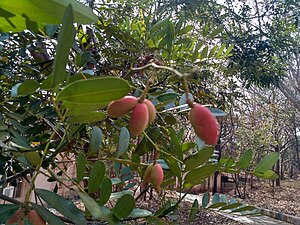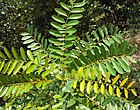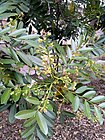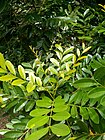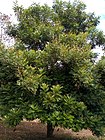Note: This is a project under development. The articles on this wiki are just being initiated and broadly incomplete. You can Help creating new pages.
Difference between revisions of "Simarouba glauca"
(→Photo Gallery) |
|||
| Line 1: | Line 1: | ||
{{stub}} | {{stub}} | ||
| − | [[File: | + | [[File:Simarouba glauca fruits 2.jpeg|thumb|right]] |
'''Simarouba glauca''' is an evergreen, small or medium-sized tree with a narrow crown. It usually grows up to 15 metres tall. but specimens up to 27 metres are recorded. The straight, cylindrical bole can be free of branches for up to 9 metres, 30cm or more in diameter. The plant is often used for medicinal purposes. | '''Simarouba glauca''' is an evergreen, small or medium-sized tree with a narrow crown. It usually grows up to 15 metres tall. but specimens up to 27 metres are recorded. The straight, cylindrical bole can be free of branches for up to 9 metres, 30cm or more in diameter. The plant is often used for medicinal purposes. | ||
Latest revision as of 14:56, 20 October 2021
Simarouba glauca is an evergreen, small or medium-sized tree with a narrow crown. It usually grows up to 15 metres tall. but specimens up to 27 metres are recorded. The straight, cylindrical bole can be free of branches for up to 9 metres, 30cm or more in diameter. The plant is often used for medicinal purposes.
Contents
- 1 Uses
- 2 Parts Used
- 3 Chemical Composition
- 4 Common names
- 5 Properties
- 6 Habit
- 7 Identification
- 8 List of Ayurvedic medicine in which the herb is used
- 9 Where to get the saplings
- 10 Mode of Propagation
- 11 Cultivation Details
- 12 Commonly seen growing in areas
- 13 Photo Gallery
- 14 References
- 15 External Links
Uses
Malaria, Fever, Dysentery, Cancer, Leukaemia, Diarrhoea, Haemorrhages, Intestinal parasites, Colitis.
Parts Used
Chemical Composition
Common names
| Language | Common name |
|---|---|
| Kannada | |
| Hindi | |
| Malayalam | |
| Tamil | |
| Telugu | |
| Marathi | |
| Gujarathi | |
| Punjabi | |
| Kashmiri | |
| Sanskrit | |
| English | Areca nut |
Properties
Reference: Dravya - Substance, Rasa - Taste, Guna - Qualities, Veerya - Potency, Vipaka - Post-digesion effect, Karma - Pharmacological activity, Prabhava - Therepeutics.
Dravya
Rasa
Guna
Veerya
Vipaka
Karma
Prabhava
Habit
Identification
Leaf
| Kind | Shape | Feature |
|---|---|---|
Flower
| Type | Size | Color and composition | Stamen | More information |
|---|---|---|---|---|
| Flowering season is December to April |
Fruit
| Type | Size | Mass | Appearance | Seeds | More information |
|---|---|---|---|---|---|
| Fruiting season is December to April |
Other features
List of Ayurvedic medicine in which the herb is used
Where to get the saplings
Mode of Propagation
Cultivation Details
A plant of the moist, lowland tropics, where it is found at elevations up to 800 metres. It grows best in areas where the mean annual temperature ranges between 22 - 29°c, but can tolerate a range of 18 - 34°c. It prefers a mean annual rainfall in the range 2,000 - 3,000mm, but tolerates 1,200 - 4,000mm, growing in areas with a distinct dry season and where there is no dry season.[3]
Commonly seen growing in areas
Dry forest or thickets, Dry open rocky hillsides.
Photo Gallery
References
External Links
- []
- []
- []
- Pages using duplicate arguments in template calls
- Pages that are stubs
- Ayurvedic Herbs known to be helpful to treat Malaria
- Ayurvedic Herbs known to be helpful to treat Fever
- Ayurvedic Herbs known to be helpful to treat Dysentery
- Ayurvedic Herbs known to be helpful to treat Cancer
- Ayurvedic Herbs known to be helpful to treat Leukaemia
- Ayurvedic Herbs known to be helpful to treat Diarrhoea
- Ayurvedic Herbs known to be helpful to treat Haemorrhages
- Ayurvedic Herbs known to be helpful to treat Intestinal parasites
- Ayurvedic Herbs known to be helpful to treat Colitis
- Herbs with Fruit used in medicine
- Herbs with Seed used in medicine
- Herbs with common name in English
- Habit - Evergreen Tree
- Index of Plants which can be propagated by Seed
- Herbs that are commonly seen in the region of Dry forest or thickets
- Herbs that are commonly seen in the region of Dry open rocky hillsides
- Ayurvedic Medicine
- Pages without herbs images
